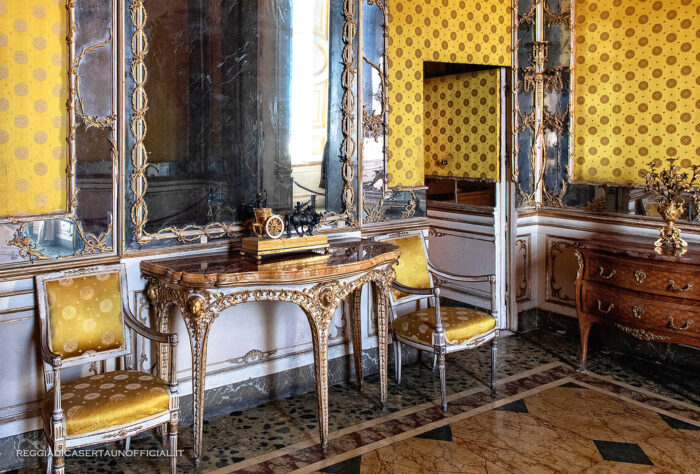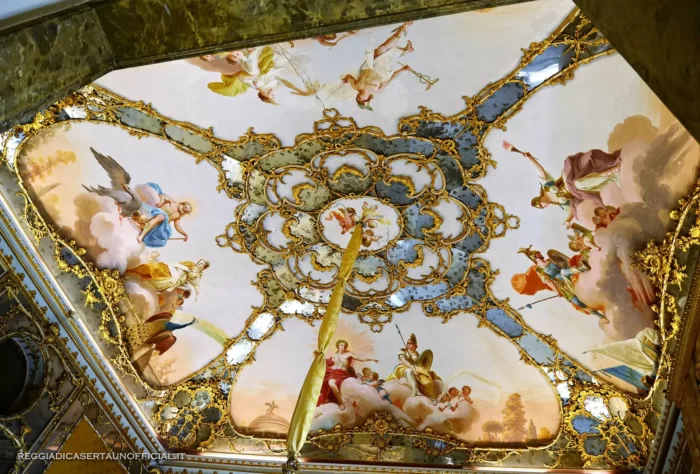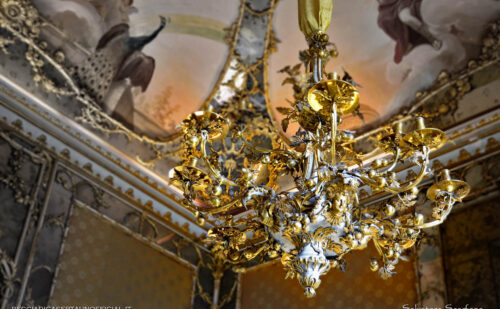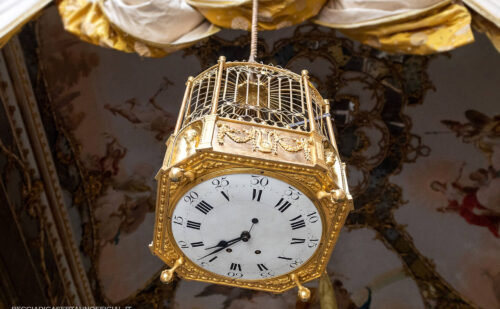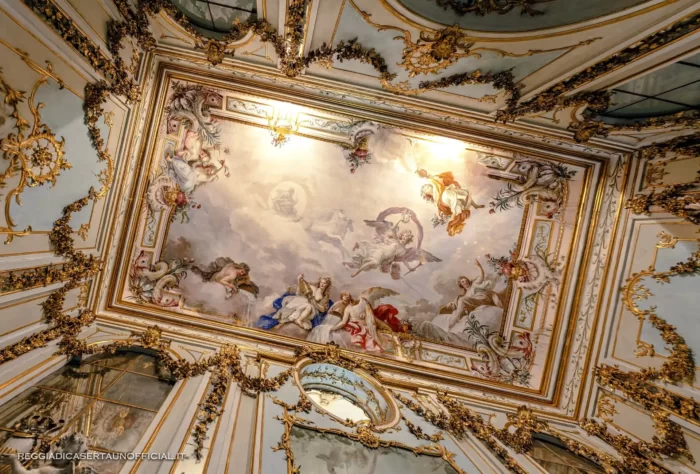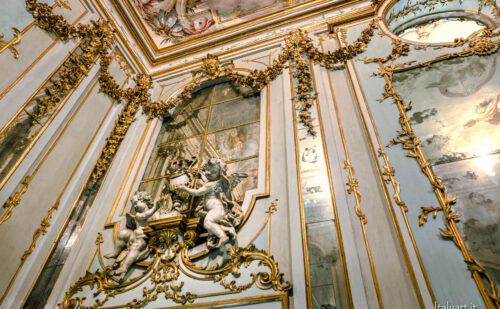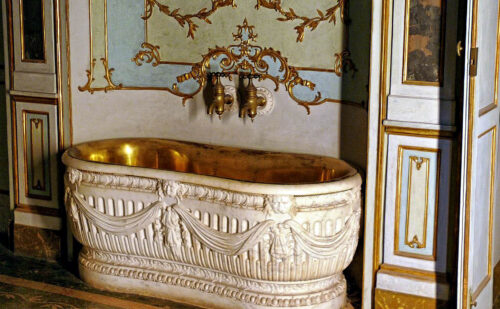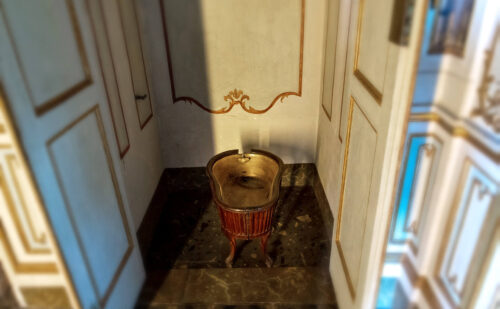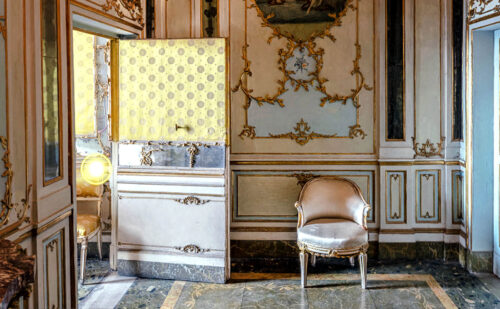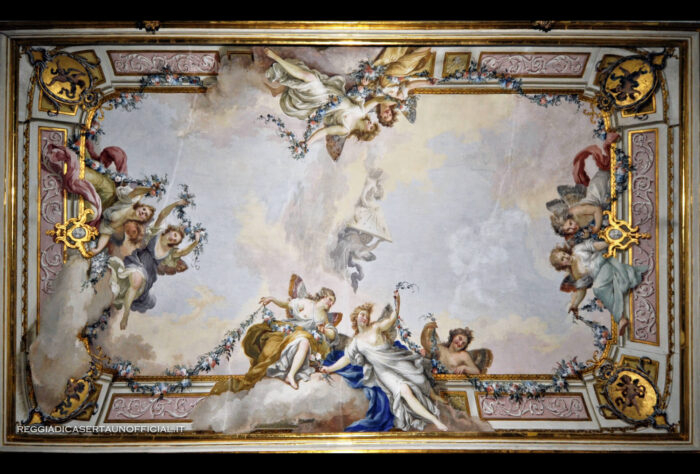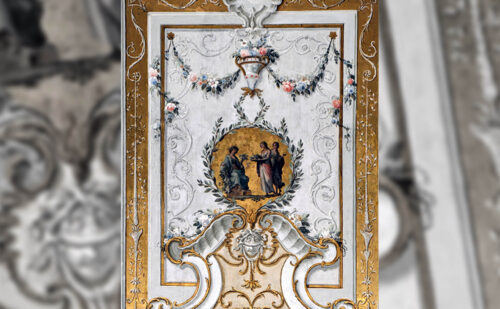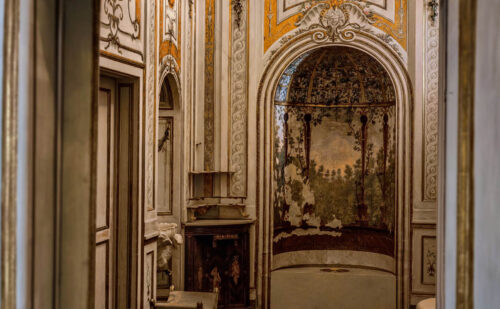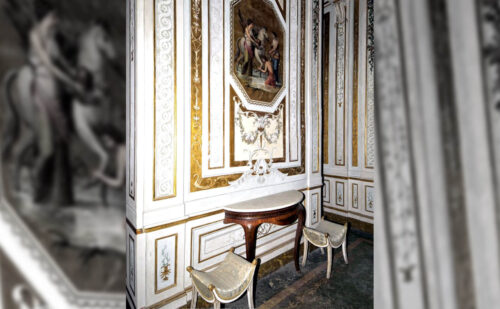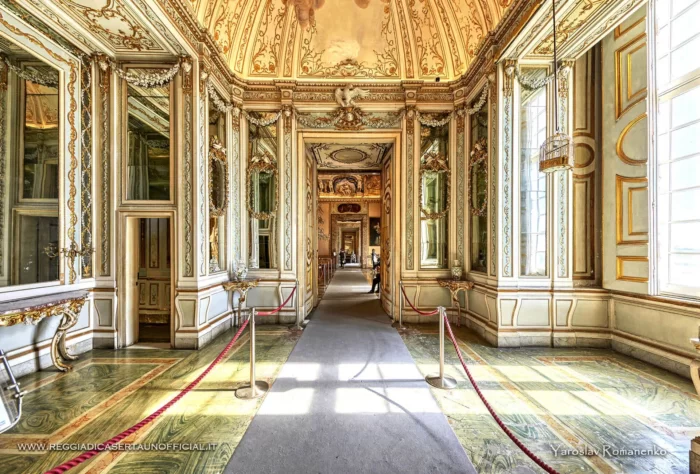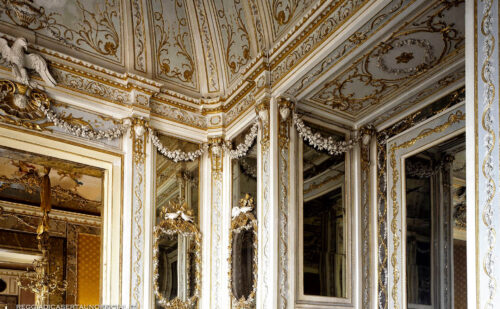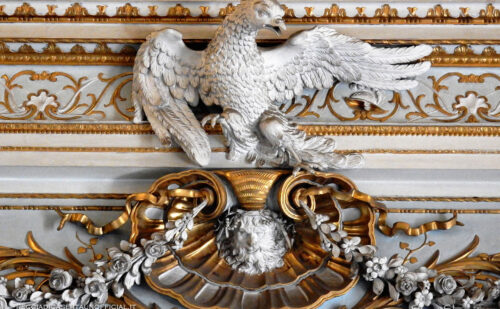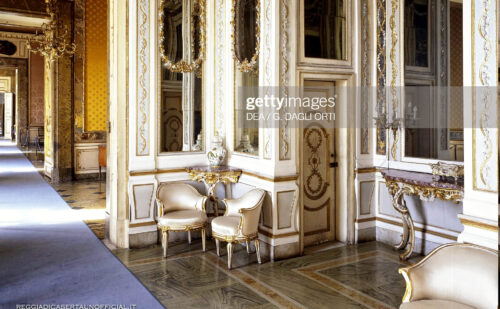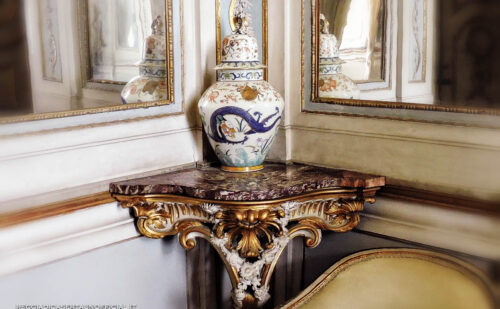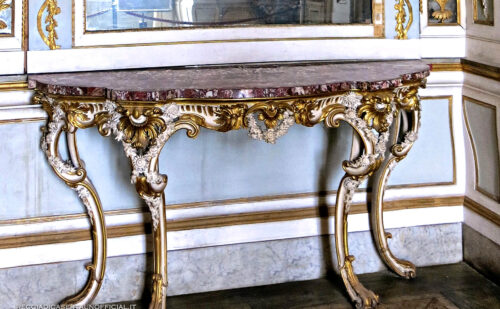Queen Maria Carolina's Bathroom and Boudoir
Queen Maria Carolina's bathroom and boudoir consist of a work room, bathroom, wardrobe and dressing room. They are a treasure chest of Rococo art.
Description of the bathroom
The bathroom and the Boudoir of Queen Maria Carolina, located next to the Bedroom, were commissioned by Queen Maria Carolina of Austria, and built by the architect Carlo Vanvitelli. They consist of five rooms:
- work room;
- bath room;
- toilet room;
- dressing room (called Stanza degli Stucchi);
- wardrobe.
These rooms were not only used for toilet and bath, but also for embroidery, drawing, music study, etc., and are a triumph of the Rococo style, and the furnishings are of various Rococo and Neoclassical styles. The Murano mirrors, enormous in size and therefore very expensive at the time (they were a status symbol) were purchased by the master Briati of Venice through the collaboration between the major butler the Prince of Francavilla and the ambassador in Venice, Count Giuseppe Finocchietti.
These rooms commissioned by Queen Maria Carolina, express all the Rococo taste for the care of female beauty and were probably inspired by the famous Porcelain Salon in Portici (now in the Capodimonte Museum), created by Giuseppe Gricci and wanted by the previous Queen, Maria Amalia of Saxony.
Queen's Working Room
The Queen’s Work Room is a triumph of Murano mirrors. In fact, the walls are covered in yellow silk with mirror frames and gilded applications made by Gennaro Fiore. Even the ceiling has mirrors. Considering that at the time the mirror was a status symbol, this room communicated the sense of beauty and luxury of her client, Queen Maria Carolina.
Decorations and furnishings
The Queen’s Work Room has walls covered in yellow silk with mirror frames and gilded applications made by Gennaro Fiore. In ancient times the walls were covered in silk with flowers on a white background, in order to create a sort of porcelain capsule (remember the famous Capodimonte Porcelain Lounge). Having been damaged during the Neapolitan Revolution of 1799, it was later replaced by this completely different current one.
The room is equipped with small but extraordinary furnishings such as the extraordinary chandelier with tomatoes and the five-legged console by Gennaro Fiore, and the musical clock by Jacques Pierre Drotz, a gift from Queen Marie Antoinette of France to her sister Maria Carolina.
In ancient times there were also oriental porcelain sculptures positioned on the shelves in the corners and on the mirror.
Gennaro di Fiore – Chandelier with tomatoes in wood and gilded metals
Pierre Jacques Drotz – Musical cage clock, gift from Queen Marie Antoinette of France to her sister Maria Carolina
The Queen's Bath
The bathroom is not currently open to the public for reasons of protection of the same.
The Bath in Queen Maria Carolina’s Boudoir consists of two main rooms: the Bath Room and the Toilet Room. The project is by Carlo Vanvitelli, including the furnishings, the applications are in gilded lead by Gennaro Fiore, while the gilding is by Bartolomeo di Natale.
Queen Maria Carolina, as well as Queen Marie Antoinette of France, were daughters of Maria Theresa of Austria, and both wanted to have a complete bathroom in their palace with running water, a bidet and a toilet with sewage system, a real exception to the tradition. era.
During the Second World War the Royal Palace of Caserta was occupied first by the Germans and then by the American troops who made it their headquarters. This also caused considerable damage to the Boudoir of Queen Maria Carolina, in particular to the Bathroom, and frescoes were damaged, furnishings and a sculpture were stolen, and the toilet was destroyed.
The Bath Room
Decorations and Furnishings
The frescoes in this room are all by Fedele Fischetti (1732-1792). The ceiling fresco has “Aurora” as its theme, while those on the walls, framed by plant elements in gilded lead, represent “The Three Graces”, “Diana and Actaeon” and “The Birth of Venus”.
The walls are decorated with plant decorations and festoons of Herculaneum origin, made by Gennaro Fiore and gilded by Bartolomeo di Natale. They are accompanied by huge and very expensive mirrors, and there is an oculus that was used to light up the hall.
The marble base of the bathtub was created by Lorenzo and Francesco Marescalchi, while the sculptural part is the work of Gaetano Salomone with the collaboration of Paolo Persico and Tommaso Bucciano. Matteo Zecchino created the copper tub, beating a sheet of copper to obtain its shape. He has hot and cold taps.
The bidet, at the time, was even equipped with a tap and drain, and was the first ever bidet in Italy. When, after the unification of Italy, the Reggia was inventoried by the Savoys, the Piedmontese employees, not knowing what it was, described it as a “strange object in the shape of a guitar”.
The toilet room
Decorations and Furnishings
The ceiling fresco in this room is the work of Fedele Fischetti (1732-1792), and has the theme “The Sundial”. The frescoes on the walls are, however, the work of Filippo di Pasquale, and have figures on a gold background taken from decorative repertoires from Pompeii and Herculaneum in which dancers and nymphs, surrounded by volutes and laurel crowns and are well suited, with their grace they are suitable for a feminine destination environment such as the bathroom.
In the niche with the toilet there is currently only a makeover, as the toilet was destroyed by the Allies during the occupation in the Second World War. It originally consisted of an inlaid wooden seat with an opening top, a brass lid and a handle for draining the water. The water was brought from the park by the Fontaniere di Corte Filippo Carpi, who made it reach the boilers.
The wardrobe
The Cabinet of Stuccos
This is the Queen’s Dressing Room (called Sala degli Stucchi), the place where, assisted by the ladies-in-waiting, she used to make herself beautiful. As in the other rooms, here too we witness an extraordinary work by Gennaro di Fiore based on a project by Carlo Vanvitelli as, moreover, the entire Boudoir of Queen Maria Carolina.
The fresco
The fresco is the work of Fedele Fischetti, it represents “The Three Graces adorning Venus” and has relief gilding. Considering that this was the Queen’s dressing room, the decision to represent Venus, the goddess of beauty, surrounded by nymphs who help her make herself beautiful, clearly refers to the Queen and her ladies-in-waiting.
Decorations and furnishings
The talent of Carlo Vanvitelli designed a room which, while maintaining a Rococo grace, dilutes it within decorative panels and bands that allude to a classic-type aesthetic.
The consoles and corner units (design by Carlo Vanvitelli) are of a notable level, while the armchairs are of great modernity. Jacques Pierre Drotz’s musical clock, a gift from Queen Marie Antoinette of France to her sister Maria Carolina. There are also 4 Japanese vases from the 18th century, two of which are in relief.
Pierre Jacques Drotz – Musical cage clock, gift from Queen Marie Antoinette of France to her sister Maria Carolina


